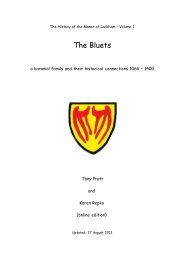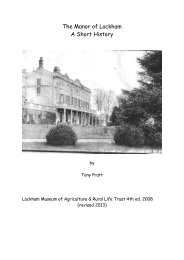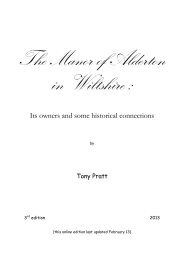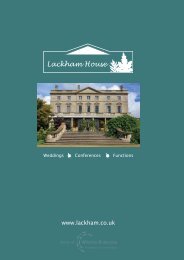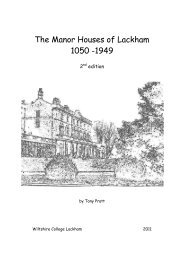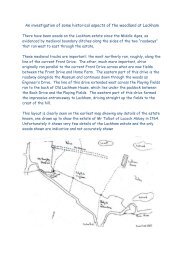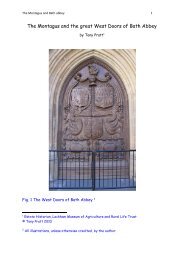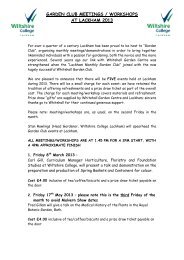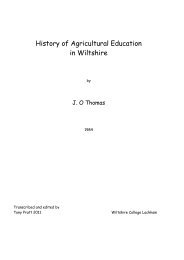Vol 3 - Lackham Countryside Centre
Vol 3 - Lackham Countryside Centre
Vol 3 - Lackham Countryside Centre
Create successful ePaper yourself
Turn your PDF publications into a flip-book with our unique Google optimized e-Paper software.
The Manor of <strong>Lackham</strong> <strong>Vol</strong> 3 : The Montagu family<br />
Richard Nott White Cross Ground 34<br />
Anne Tayler Catteridge Farm 471 570<br />
Robert Ray Cuckoo Bush Farm 300<br />
Ray Grist Mill plus lands and 130<br />
cottage at Raybridge occupied by<br />
William Davies 472<br />
Joseph Wheeler Ray Cloth Mill and Land 130<br />
The 1821 leases provide an insight into the agriculture being practiced<br />
on the estate in the early nineteenth century. Rotations were being<br />
specified, for example, James Hancock’s lease for land at Showell was to<br />
be Arable, except for Dry Ground (about 10 acres, which doesn’t actually<br />
leave a lot to be arable from a rental of 12 acres!). Dry Ground was<br />
to be planted with “peas or potatoes” in 1821, “vetches or turnips” in<br />
1822 and wheat in 1823 with a grass underlay so that the ground could<br />
be returned to pasture afterwards. The turnips / vetches were to be<br />
“eaten on the land”, probably by pigs. This was not uncommon, it fed the<br />
pigs and nutrients were returned directly to the field with the dung.<br />
Repairs to Mills were a common requirement, and when the lease for Ray<br />
Mill came up for renewal in 1824 John Cornish offered a rental of £160<br />
per annum (on behalf of his son in law James Ray) for Ray Grist Mill, one<br />
provision being that “the tenant will do the repairs – being allowed rough<br />
materials – but with the exception of blowing the hatches and sheeting”<br />
As has already been seen, the Lacock area was involved in the Wiltshire<br />
Weaving industry. James Montagu rented a cottage and pasture on<br />
Bewley Common to James Hillier of Lacock “a weaver” in 1792 473 . It is<br />
known that Ray Mill was used for both corn and weaving activities:<br />
471<br />
The rent was to be offset against Mrs Tayler’s expenses incurred for land<br />
drainage she was undertaking.<br />
472 Mr Ray was objecting to paying for repairs to the Mill – the agent suggested that<br />
the rental should be increased if the estate undertook the repairs<br />
473 W&SHC 137/59-7<br />
117



